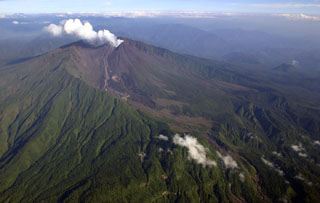Report on Reventador (Ecuador) — 5 November-11 November 2008
Smithsonian Institution / US Geological Survey
Weekly Volcanic Activity Report, 5 November-11 November 2008
Managing Editor: Sally Sennert.
Please cite this report as:
Global Volcanism Program, 2008. Report on Reventador (Ecuador) (Sennert, S, ed.). Weekly Volcanic Activity Report, 5 November-11 November 2008. Smithsonian Institution and US Geological Survey.
Reventador
Ecuador
0.077°S, 77.656°W; summit elev. 3562 m
All times are local (unless otherwise noted)
The IG reported that SOTE (Sistema de Oleoducto Transecuatoriano) personnel and residents near Reventador observed incandescence in the crater on 7 November. The reports were confirmed by the presence of thermal anomalies in satellite imagery. The next day, seismicity increased and a steam-and-ash plume rose to an approximate altitude of 5.6 km (18,400 ft) a.s.l. and drifted SW. Incandescent blocks were ejected from the inner crater to the S. Residents in El Chaco (about 35 km SE) and in the Quijos area heard strong explosions and saw steam plumes with low ash content. A pilot reported that a steam plume with little ash content at an altitude of 7.6 km (25,000 ft) a.s.l. drifted NW. On 9 November incandescent blocks were ejected 100 m into the air, and roaring and "cannon shot" sounds were reported. Strombolian activity and two lava flows that descended the N and S flanks of the central cone were observed using a permanent camera. Slight ashfall was noted in Cayambe, about 55 km WNW. A thermal anomaly was detected by satellite imagery on 9 and 10 November. On 10 November, seismicity considerably decreased and gas emissions continued. The lava flows continued to advance.
According to a news article, officials suspended flights into Quito airport due to ash plumes on 10 November for three hours as a preventative measure.
Geological Summary. Volcán El Reventador is the most frequently active of a chain of Ecuadorian volcanoes in the Cordillera Real, well east of the principal volcanic axis. The forested, dominantly andesitic stratovolcano has 4-km-wide avalanche scarp open to the E formed by edifice collapse. A young, unvegetated, cone rises from the amphitheater floor to a height comparable to the rim. It has been the source of numerous lava flows as well as explosive eruptions visible from Quito, about 90 km ESE. Frequent lahars in this region of heavy rainfall have left extensive deposits on the scarp slope. The largest recorded eruption took place in 2002, producing a 17-km-high eruption column, pyroclastic flows that traveled up to 8 km, and lava flows from summit and flank vents.
Sources: Instituto Geofísico-Escuela Politécnica Nacional (IG-EPN), Washington Volcanic Ash Advisory Center (VAAC), Associated Press

